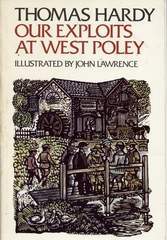Inspiring Young Readers
 posted on 15 Dec 2016
posted on 15 Dec 2016
Our Exploits At West Poley by Thomas Hardy
Our Exploits At West Poley is Thomas Hardy’s only extant attempt to write for the children’s reading market – and only survives today by chance and good fortune. It was conceived of as a submission to an American periodical called the Youth’s Companion and written in such a way that it could be serialised over several editions. However, having taken time to write, re-edit and restructure the piece the editor confounded Hardy’s expectations by consigning it to a substantial pile marked ‘to be used at some point in the future’. There it languished without being published until another even more obscure Bostonian magazine called The Household picked it up and decided to print it. However, this magazine’s reach was tiny and it’s unlikely that very many people ever knew of the story’s existence. It took another 60 years before it was rediscovered and published as a stand-alone book in 1952 with an introduction explaining this back story written by Richard L. Purdy – which is also reproduced in this later copy that I have just read.
Set in the Mendips, at the outer extremes of Hardy’s Wessex, the story involves the adventures of two boys aged 13 and 15 who go exploring some local caves. Stumbling across an underground stream that blocks their path to further caverns they divert the direction of the stream in order to gain access – something which they rather pride themselves on. All is well and good until they discover that this underground stream is in fact the source of the river and water supply of West Poley, the village they live in. They begin to realise the consequences of their actions as businesses are ruined and lives disrupted. Things get way more complicated when they then discover that they have diverted the river to East Poley – previously waterless – and massively improved the lives of those residents.
So what should they do? If they divert the river course back to the way it was and satisfy the needs of West Poley, the East Poley residents will then be deprived of the water. So instead they decide the way to solve the problem is to find a third way – to divert the water down another cave hole so that neither East or West Poley get the water. And that turns out to be a life threatening decision….
To find out why you will have to read the book because I’m not going to reveal what happens here.
Along the way the story develops a couple of sub-plots involving a brutal mill-owner and his enslaved apprentice, an attempt by the boys to exploit their ability to control the flow of the river and a pitch battle between the residents of the two Poley’s but these are really there to further enhance the moral lessons that wind through the story like a moto runs through the length of a stick of rock. The story is told through the eyes of the youngest boy, Leonard, who is reflecting on his exploits from later adulthood and this enables an older eye and grown-up perceptions to be brought to the story.
Don’t expect any subtlety in the tale Hardy is telling – or in truth any great tension or sense of peril, despite the fact that this is clearly what he is aiming at. I think it’s probably safe to assume that the story went onto the ‘to be used later’ pile because it just wasn’t very good. Hardy is clearly not an accomplished children’s author and demonstrates here that being a great writer isn’t necessarily the same as being an effective one or one that understands the audience it’s intended for.
The pacing isn’t great, the actions of the youngsters doesn’t convince and although the story picks up a degree of momentum in the second half, it’s all a bit flat. Just occasionally the adult Hardy peeps out and does suggest a dimension that sadly remains unexplored. There is, for example, a potentially fascinating character only referred to as The Man Who Failed – a citizen of West Poley who is seen by everyone as a broken man who failed in life but who proves to have the wisdom of someone who has faced adversity. But sadly he isn’t fully developed as a character and you get the distinct feeling that Hardy had to draw himself back from his creation and reluctantly let the chance slide past because this isn’t a character right for a children’s adventure.
The copy I have is a later reprint with some lovely woodcut illustrations by the great John Lawrence. Happily this reprint is pretty cheap to buy if you’re interested in finding out why Hardy never would have made it as a children’s author.
Terry Potter
December 2016

